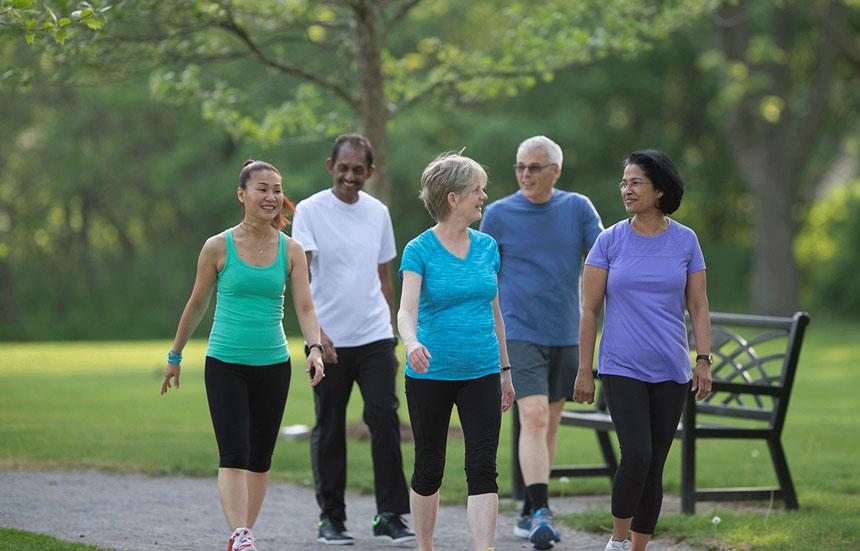Why Do We Move Slower as We Age?

Most of us slow down as we age. We schedule fewer activities, relax more and get more rest. After raising children and retiring from careers, taking it easy can be a welcomed change. But slowing down also can be more literal like walking at a slower pace. This type of slowing down suggests your body is aging.
“How long it takes us to walk a specific distance on a level surface is an indicator of your overall health and life expectancy,” says Bernard Kaminetsky, MD, medical director, MDVIP. “Technically, it’s called gait speed and it’s often included in the MDVIP Wellness Program.”
Why Do We Walk Slower as We Age?
Moving slower is a natural part of aging. Medical News Today cited several theories as to why, including:
• Lower activity levels
• Slower metabolism
• Muscle loss
However, University of Colorado researchers think energy expenditure also plays a role. Older adults move slower than younger adults because it takes more work to move at a quicker pace, according to a study published The Journal of Neuroscience. Our brain’s reward circuit, which encourages us to move and exercise, declines as we age, making physical activity more difficult. Researchers feel results from this study may lead to new diagnostic tools for diseases that involve movement issues such as Parkinson’s disease and multiple sclerosis.
“In my experience, these variables are interconnected. If you’re not able to remain active, you’ll lose muscle mass, and your metabolism slows, causing you’ll feel less energetic and slowing your gait,” says Kaminetsky.
Why is our Walk Speed Important?
Walking requires energy to move, balance and breathe quicker. It places demands on the heart and lungs, and musculoskeletal, circulatory, pulmonary and nervous systems. These systems are necessary for survival, making walking speed a lifespan gauge, according to a study published in JAMA. Furthermore, slower walking speeds are associated with a higher risk of frailty, according to a study published in BMC Family Practice, while quicker walking speeds indicate better functionality and a lower risk of type 2 diabetes, according to a study published in the British Journal of Sports Medicine.
Gait Speed Testing
Gait speed tests assess your functional mobility, i.e., your ability to move independently and safely in various settings so that you can perform daily activities such as bathing, dressing, eating, cooking, cleaning, shopping, driving and getting around. It also can be used to evaluate cognitive skills, fall risk and overall health.
It’s an easy test that involves walking a short distance (usually five meters) at your normal pace. You will probably be asked to repeat this test three times.
Test results will be based on your average time, gender and age and give you an idea of how fast you walk compared to give your peers. If your gait speed is a slow, your doctor may advise you to work with a fitness professional.
What is considered a slow walking speed?
Len Kravitz, PhD, exercise science professor and program coordinator, University of Mexico, breaks down walking speeds for adults 65 and older this way:
- Speeds ≤ 1.3 miles per hour suggest poor health and functional status.
- A speed of 1.8 mph is the average walking pace for this age group.
- Speeds ≥ 2.2 mph suggest healthier aging.
- Speeds ≥ 2.7 mph is believed to be exceptional life expectancy, but additional research is needed.
- Brisk walking at 3 mph or higher may enhance survival.
How Can You Maintain Your Walking Speed
Below are a few steps you can take to help maintain your walking speed.
Measure your baseline walking speed.
- Establish a specific distance to walk, e.g., a mile. You can use a local track (the inside lane is 400 meters) or measure a distance with your car odometer.
- Warm up with a brief, light walk.
- Walk as much trail you can, tracking your speed, distance and heart rate using a mobile phone app, smartwatch, fitness tracker.
- You also can estimate your exertion by assigning a number between 1 (extremely light) and 10 (extremely vigorous) to describe how hard you worked.
Start a walking program.
- Learn how to determine and monitor your target heart rate. You can invest in a fitness tracker that includes a heart rate monitor, do a talk test and or use the Borg’s Scale/Rate of Perceived Exertion.
- Practice proper walking mechanics.
- Include a proper warmup and a cool down. Warmups and cool downs should last between 5 and 10 minutes. You don’t need to do anything special, just walk at a slower pace.
- Try walking several days per week for at least 20 minutes, while staying within your target heart rate zone. With the warmup and cool down, the workout will be 30 minutes.
Challenge yourself to improve speed.
- Try walking at a faster speed while walking short distances.
- Alternate walking directions, i.e., forward, sideways and backwards. This will help improve agility, condition lesser used muscles, tendons and ligaments, and improve the mobility of joints, hips, knees and ankles.
- Carry hand-held weights while walking. If you don’t have hand-held weights, you can use water bottles.
- Strength train to help keep your muscles strong.
“Most importantly, work with your primary care physician. In fact, you should consult your PCP before beginning a walking program and keep them abreast of how it’s going,” says Kaminetsky. “Your PCP can guide you based on your conditions, medications and results from your physical exams.”
If you don’t have a primary care doctor, consider partnering with an MDVIP-affiliated physician. They have time to work with you and develop a wellness plan that can focus on walking speed. Find a physician near you and begin your partnership in health »


